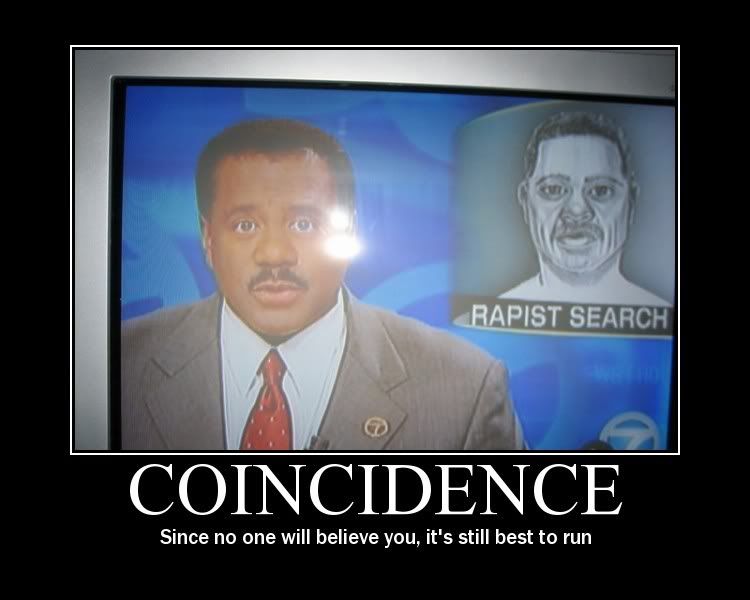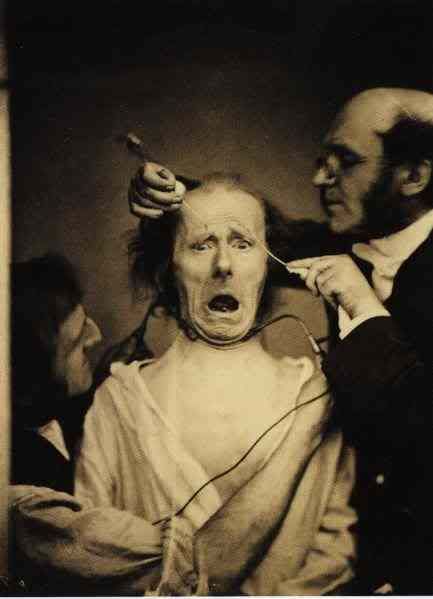Mahka Tendo is best known for his ground-breaking work with jumbo card productions which earned him a Silver Medal in Manipulation at FISM 1985. More recently he's brought out a selection of products including canes, with SEO Magic, and he was presenting a weekly magic spot on NHKTV in Japan.
Friday Magic Showcase: Mahka Tendo
Posted by Magic Tony at 5/29/2009 09:30:00 AMMotor Theory: A Bit of a Stretch?
Posted by Magic Tony at 5/28/2009 09:50:00 AMThe study outlined in the Scientific American article examined the motor contributions to speech perception in a different way. If we are constantly simulating oral gestures when listening to speech, then manipulating our own oral motor activity during speech processing should influence perception. Ito, Tiede, and Ostry (2009) presented people with an ambiguous word (somewhere in between "head" and "had") while a machine, pictured below, stretched the participants' mouths in one of three directions.

From Ito, Tiede, and Ostry (2009)
Two of the stretching directions corresponded to the way the face changes during the pronunciation of "head" and "had." The third was unrelated. As the motor theory would predict, the direction of stretching biased participants toward hearing the word that matched the facial movement, even if the token was more similar to the opposing word. The unrelated stretching condition had no discernible effect on perception. So, there's plenty of evidence that supports a motor component to speech recognition, but, as yet, no one has come up with an experimental design that can unequivocally refute motor theory (although methods in brain imagining are beginning to come close). It seems that it's largely unfalsifiable, which makes it a difficult theory to accept wholeheartedly.
P.S. If you liked the McGurk effect, you should check out this version of it combined with the Margaret Thatcher illusion.
References:
Ito, T., Tiede, M., & Ostry, D. J. (2009). Somatosensory function in speech perception. Proceedings of the National Academy of Sciences, 106, 1245-1248. (link)
Liberman, A. M. & Mattingly, I. G. (1985). The motor theory of speech perception revised. Cognition, 21, 1-36. (link)
MacDonald, J. & McGurk, H. (1978). Visual influences on speech perception processes. Perception & Psychophysics, 24, 253-257.
Penn Says: A Fatal Bullet Catch
Posted by Magic Tony at 5/27/2009 12:51:00 PMFor more information on the history of the bullet catch, I encourage you to read Jim Steinmeyer's treatise on Chung Ling Soo, The Glorious Deception.
Friday Magic Showcase: Lance Burton
Posted by Magic Tony at 5/22/2009 10:11:00 AMThe Japanese Words Quiz
Posted by Magic Tony at 5/19/2009 10:05:00 AMThe Japanese Words Quiz
On Coincidental Thinking
Posted by Magic Tony at 5/18/2009 09:22:00 AM
In my blog entry regarding "The Fallacy of Personal Validation," I hit on the topic of probability estimation. People are exceptionally bad at accounting for population base rates when making decisions and are wholly incapable of recognizing randomness when they see it. In the example of an astrological reading, people underestimate the prevalence of certain personality traits in the population, thus personalizing what is in reality a quite generic personality profile. A new study just published in the journal Applied Cognitive Psychology by Paul Rogers and colleagues suggests that this gross inability to consider probabilities may be the factor that differentiates a believer in the paranormal from a nonbeliever.
Rogers, Davis, and Fisk (2009) examined individual differences in susceptibility to the conjunction fallacy, wherein people judge a series of random events as more likely to co-occur than to occur individually. Here's a concrete example. Rogers et al. presented people with the following situation:
Billy has a long lost friend who he has not seen in years. They were good friends in school but drifted apart when they went away to different colleges. Billy comes home from work one evening and sits down to eat his dinner.They then had participants rate the probability (chance in 100) of three statements:
- a. "Billy thinks about his long lost friend."
- b. "Billy's long lost friend unexpectedly phones him."
- c. "Billy thinks about his long lost friend and suddenly his long lost friend unexpectedly phones him."
The conjunction fallacy occurs when the third item (the conjunction) is rated as more probable than either event individually (the constituents). Statistically, the conjunction should never be more probable than each constituent. Interestingly, paranormal believers (as measured by the Australian Sheep-Goat Scale) were significantly more likely than non-believers to give the conjunction a higher probability rating. Although participants who had more experience in math, statistics, and psychology made fewer conjunction fallacy errors, the effect of paranormal belief was still present when math ability was held constant.
As Cohen (1960) stated, "Nothing is so alien to the human mind as the idea of randomness."
References:
Cohen, J. (1960). Chance, skill, and luck: The psychology of guessing and gambling. Baltimore, MD: Penguin Books.
Rogers, P., Davis, T., & Fisk, J. (2009). Paranormal belief and susceptibility to the conjunction fallacy. Applied Cognitive Psychology, 23, 524-542. (link)
Friday Magic Showcase: Penn & Teller Blast Off
Posted by Magic Tony at 5/15/2009 12:50:00 PMBest Visual Illusion of the Year
Posted by Magic Tony at 5/14/2009 01:48:00 PMThe spinning of the curveball creates both a physical effect (“the curve”) and a perceptual puzzle. The curve arises because the ball’s rotation creates an imbalance of forces on different sides of the ball, which leads to a substantial deflection in the path of the ball. The perceptual puzzle arises because the deflection of the ball should appear gradual, but from the point of view of the batter standing near home plate, the flight of the ball often appears to undergo a dramatic and nearly discontinuous shift in position (this sudden shift is referred to as the curveball’s “break”).
As I can't post any of the illusions themselves on this blog, here's a related video of 10 classic optical illusions in 2 minutes.
Friday Magic Showcase: Marco Tempest
Posted by Magic Tony at 5/08/2009 10:20:00 AMThe Brain Orchestra
Posted by Magic Tony at 5/04/2009 12:57:00 PMFrom BBC News:
The performers launch sounds or affect their frequencies and modulations based on two well-characterised effects seen in EEGs: the steady-state visually evoked potential (SSVEP), and the so-called P300 signal.Two of the performers were given a task to watch a screen in front of them, with flashing rows and columns of letters, and told to look for a particular letter. When expectation is fulfilled, 300 thousandths of a second later, a signal known as the P300 appears in the EEG.
In the Multimodal Brain Orchestra, the P300 signal is registered - with a dot demarcating it on the EEG trace projected to the audience, so that they can see the effect of the performer's thought - in turn launching a sound or recorded instrument.
Two more performers were given boxes with four lights flashing at different frequencies. The SSVEP is a brain signal that comes about when visual stimulus in the retina at a given frequency causes the brain to synchronize, so that frequency appears in the EEG.
Given a cue from the conductor, the performers switch their attention from one flashing frequency to another. One of them affects the volume of a given sound - known to influence the level of arousal in the circumplex model - and the other affects a certain modulation of that sound, which is known to influence the valence, how positive or negative the arousal is emotionally.
Electrical Stimulation of the Face
Posted by Magic Tony at 5/04/2009 10:16:00 AMWatching this, I couldn't help but be reminded of the pioneering research carried out by French neurologist Guillaume Duchenne in mid-19th Century. Duchenne was interested (among other things) in the underlying physical mechanisms responsible for facial expressions. To this end, he recruited a patient with facial paralysis (pictured below with Duchenne on the right). By applying electrical stimulation to different locations on the face, he could activate a variety of muscle groups, leading to the production of some rather grotesque facial expressions.

Most notably, Duchenne is responsible for recognizing that a true smile recruits not just muscle groups in the mouth, but also those around the eyes. This is the most sure-fire way to discriminate a false smile from a true one: someone producing a fake smile doesn't show wrinkling around the eyes. Thanks to Duchenne's research, genuine smiles are sometimes referred to as "Duchenne smiles."
References:
Parent, A. (2005). Vignettes in neurology: Duchenne de Boulogne (1806-1875). Parkinsonism and Related Disorders, 11, 411-412.
Danny Gans
Posted by Magic Tony at 5/01/2009 11:47:00 AMThe Man of Many Voices has gone quiet.
Sin City performer extraordinaire Danny Gans—relatively unknown outside of Las Vegas, but a megastar on the Strip—died in his sleep early this morning at the age of 52. His cause of death was not immediately known.
While Gans began his career as a pro baseball player, eventually nabbing a bit part in Bull Durham, he has been a Vegas mainstay since 1996 and, befitting his stature, had the honor of possessing the largest freestanding marquee in the world.






